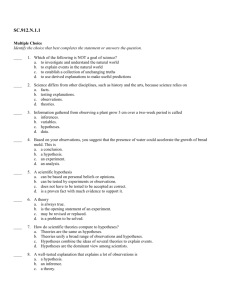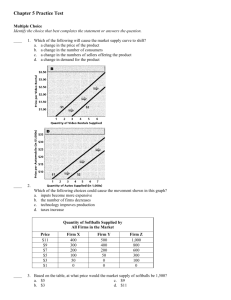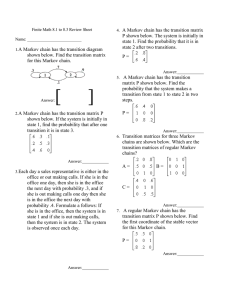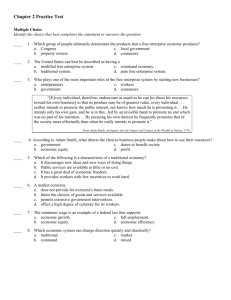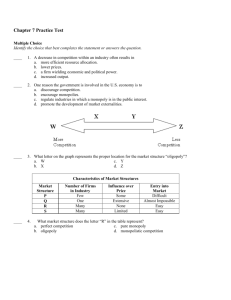7A nad B practice test
advertisement
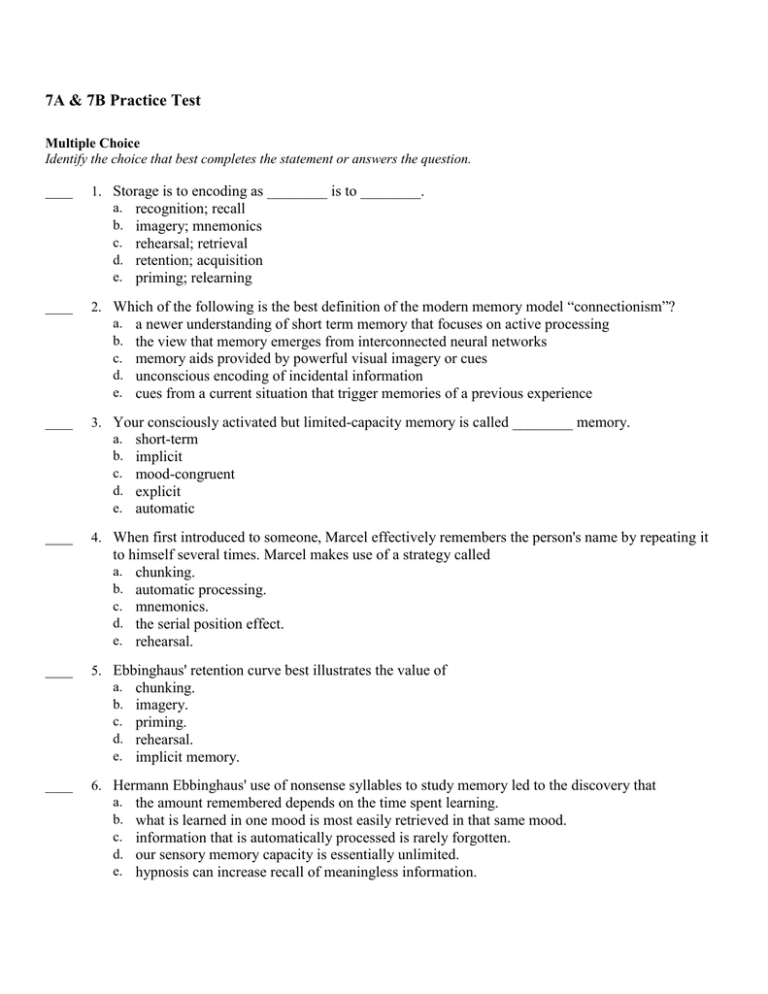
7A & 7B Practice Test Multiple Choice Identify the choice that best completes the statement or answers the question. ____ 1. Storage is to encoding as ________ is to ________. a. recognition; recall b. imagery; mnemonics c. rehearsal; retrieval d. retention; acquisition e. priming; relearning ____ 2. Which of the following is the best definition of the modern memory model “connectionism”? a. a newer understanding of short term memory that focuses on active processing b. the view that memory emerges from interconnected neural networks c. memory aids provided by powerful visual imagery or cues d. unconscious encoding of incidental information e. cues from a current situation that trigger memories of a previous experience ____ 3. Your consciously activated but limited-capacity memory is called ________ memory. a. short-term b. implicit c. mood-congruent d. explicit e. automatic ____ 4. When first introduced to someone, Marcel effectively remembers the person's name by repeating it to himself several times. Marcel makes use of a strategy called a. chunking. b. automatic processing. c. mnemonics. d. the serial position effect. e. rehearsal. ____ 5. Ebbinghaus' retention curve best illustrates the value of a. chunking. b. imagery. c. priming. d. rehearsal. e. implicit memory. ____ 6. Hermann Ebbinghaus' use of nonsense syllables to study memory led to the discovery that a. the amount remembered depends on the time spent learning. b. what is learned in one mood is most easily retrieved in that same mood. c. information that is automatically processed is rarely forgotten. d. our sensory memory capacity is essentially unlimited. e. hypnosis can increase recall of meaningless information. ____ 7. The tendency for distributed study to yield better long-term retention than massed study is known as a. the serial position effect. b. state-dependent memory. c. the spacing effect. d. long-term potentiation. e. chunking. ____ 8. Students often remember more information from a course that spans an entire semester than from a course that is completed in an intensive three-week learning period. This best illustrates the importance of a. long-term potentiation. b. the serial position effect. c. automatic processing. d. implicit memory. e. the spacing effect. ____ 9. Semantic encoding refers to the processing of a. sounds. b. meanings. c. visual images. d. unfamiliar units. e. touch sensations. ____ 10. The process by which information is encoded by its meaning is called a. long-term potentiation. b. automatic processing. c. rehearsal. d. mnemonic encoding. e. semantic encoding. ____ 11. Children can better remember an ancient Latin verse if the definition of each unfamiliar Latin word is carefully explained to them. This best illustrates the value of a. iconic memory. b. semantic encoding. c. rosy retrospection. d. the peg-word system. e. long-term potentiation. ____ 12. One reason adults typically recall little of their first three years of life is that during infancy they were unable to verbally label most of their experiences. This best illustrates that the formation of long-term memories often requires a. automatic processing. b. implicit memory. c. acoustic encoding. d. source amnesia. e. semantic encoding. ____ 13. Craik and Tulving experimentally demonstrated that people effectively remember seeing a specific word after they decide whether that word fits into an incomplete sentence. This research highlighted the effectiveness of a. priming. b. the “peg-word” system. c. automatic processing. d. semantic encoding. e. the serial position effect. ____ 14. The address for obtaining tickets to a popular quiz show flashes on the TV screen, but the image disappears before Sergei has had a chance to write down the complete address. To his surprise, however, he has retained a momentary mental image of the five-digit zip code. His experience best illustrates ________ memory. a. iconic b. flashbulb c. implicit d. echoic e. state-dependent ____ 15. Research by Kandel and Schwartz on sea slugs indicates that memory formation is associated with the a. b. c. d. e. structure of DNA molecules. release of certain neurotransmitters. activity level of the hippocampus. development of the cerebellum. transformation of neurons in the medulla. ____ 16. Many people retain their classically conditioned fears without any conscious recollection of how or when those fears were learned. This best illustrates ________ memory. a. implicit b. short-term c. sensory d. working e. state-dependent ____ 17. Where are explicit memories of newly learned verbal information and visual designs stored? a. Verbal information is stored in the right hippocampus and visual designs are stored in the left hippocampus. b. Verbal information is stored in the left hippocampus and visual designs are stored in the right hippocampus. c. Verbal information is stored in the left hippocampus and visual designs are stored in the right cerebellum. d. Verbal information is stored in the right cerebellum and visual designs are stored in the left cerebellum. e. Verbal information is stored in the left cerebellum and visual designs are stored in the right cerebellum. ____ 18. Unlike implicit memories, explicit memories are processed by the a. b. c. d. e. hippocampus. cerebellum. hypothalamus. motor cortex. corpus callosum. ____ 19. Fill-in-the-blank test questions measure ________; matching concepts with their definitions measures ________. a. recognition; relearning b. recall; recognition c. recall; relearning d. relearning; recall e. recognition; rehearsal ____ 20. Information learned while a person is ________ is best recalled when that person is ________. a. sad; happy b. drunk; sober c. angry; calm d. fearful; happy e. drunk; drunk ____ 21. When Bryan's girlfriend broke up with him, he felt very down. As he sat in his bedroom, he thought about all of the other times his heart had been broken. Bryan's experience provides an example of a. retroactive interference. b. implicit memory. c. mood-congruent memory. d. iconic memory. e. long-term potentiation. ____ 22. To prevent encoding failure you should a. avoid source amnesia. b. limit parallel processing. c. engage in effortful processing. d. stop long-term potentiation. e. encourage priming. ____ 23. Harry Bahrick observed that three years after people completed a Spanish course, they had forgotten much of the vocabulary they had learned. This finding indicates that information is lost while it is a. encoded. b. rehearsed. c. retrieved. d. in storage. e. relearned. ____ 24. The title of a song is on the tip of Gerard's tongue, but he cannot recall it until someone mentions the songwriter's name. Gerard's initial inability to recall the title was most likely caused by a. a physical decay of stored memory. b. encoding failure. c. state-dependent memory. d. retrieval failure. e. repression. ____ 25. A type of motivated forgetting in which anxiety-arousing memories are blocked from conscious awareness is known as a. retroactive interference. b. proactive interference. c. the spacing effect. d. repression. e. priming. ____ 26. As we retrieve memories from our memory bank, we often alter them based on past experiences and our current expectations. This best illustrates a. implicit memory. b. proactive interference. c. the spacing effect. d. memory construction. e. serial position effect. ____ 27. Your friend told you that eating chocolate was shown to improve memory recall. You may later recall this “fact” but forget where you heard it. You assume that you heard it on the news, a credible source, so you begin eating chocolate. Your behavior best illustrates a. implicit memory. b. mood-congruent memory. c. source amnesia. d. retroactive interference. e. motivated forgetting. ____ 28. To gain accurate eyewitness testimony from children, interviewers must a. be sensitive to repressed memories. b. provide details to the child before the interview. c. use neutral words that children can understand. d. employ leading questions to prompt a response. e. allow children to listen to adults discuss the case before the interview. ____ 29. In one study, children were periodically asked whether they remembered going to the hospital with a mousetrap on their finger. This experiment best illustrated the dynamics of a. memory construction. b. long-term potentiation. c. flashbulb memory. d. sensory memory. e. mood-congruent memory. ____ 30. When children are interviewed about their recollections of possible sexual abuse, their reports are especially credible if a. they are asked specific, detailed questions about the issue rather than more general, open-ended questions. b. after responding to an interviewer, they are repeatedly asked the same question they just answered. c. they use anatomically correct dolls to indicate if and where they had been physically touched. d. involved adults have not discussed the issue with them prior to the interview. e. they express strong feelings about the memories and seem convinced that the memories are accurate. ____ 31. Participants in one experiment were given entirely fabricated accounts of an occasion in which they had been lost in a shopping mall during their childhood. Many of these participants later falsely recollected vivid details of the experience as having actually occurred. This experiment best illustrated a. the self-reference effect. b. mood-congruent memory. c. the misinformation effect. d. proactive interference. e. the spacing effect. ____ 32. Prototypes are especially important in the process of a. belief perseverance. b. trial and error. c. constructing algorithms. d. choosing heuristics. e. classifying objects. ____ 33. People more easily detect male prejudice against women than female prejudice against men because the former more closely resembles their prejudice a. premise. b. heuristic. c. algorithm. d. prototype. e. fixation. ____ 34. Eva had difficulty recognizing that a sea horse was a fish because it did not closely resemble her fish a. hierarchy. b. heuristic. c. algorithm. d. prototype. e. fixation. ____ 35. Jerome believes that his 4-year-old grandson is a hyperactive child because the boy's constant movement resembles Jerome's prototype of hyperactivity. Jerome's thinking best illustrates a. belief perseverance. b. the availability heuristic. c. the representativeness heuristic. d. functional fixedness. e. the framing effect. ____ 36. Our tendency to judge the likelihood of an event on the basis of how readily we can remember instances of its occurrence is called the a. framing effect. b. belief perseverance phenomenon. c. confirmation bias. d. representativeness heuristic. e. availability heuristic. ____ 37. Dean overestimates the proportion of family chores for which he takes sole responsibility because it's easier for him to recall what he has done than to recall what other family members have done. This best illustrates the impact of a. overconfidence. b. functional fixedness. c. the representativeness heuristic. d. confirmation bias. e. the availability heuristic. ____ 38. After learning that her two best friends had lost their jobs, Mariah began to grossly overestimate the national unemployment rate. Mariah's reaction best illustrates the consequences of a. confirmation bias. b. the availability heuristic. c. the representativeness heuristic. d. the belief perseverance phenomenon. e. the framing effect. ____ 39. In suggesting that our ancestral history has prepared us to fear snakes, psychologists are emphasizing that what we fear is influenced by a. genetic factors. b. belief perseverance. c. the availability heuristic. d. framing. e. environmental situations. ____ 40. After taking two years of college economics courses, Lionel thinks he knows enough about business to become a millionaire. Lionel should become more aware of a. the representativeness heuristic. b. functional fixedness. c. the belief perseverance phenomenon. d. overconfidence. e. the framing effect. ____ 41. Students routinely underestimate how much time it will take them to complete assigned course projects. This best illustrates the impact of a. framing. b. functional fixedness. c. the availability heuristic. d. the representativeness heuristic. e. overconfidence. ____ 42. The value of generating positive first impressions in your initial interactions with a new employer is best underscored by the research on a. overconfidence. b. the framing effect. c. belief perseverance. d. functional fixedness. e. the representativeness heuristic. ____ 43. Without awareness, we often use highly adaptive heuristics. This best illustrates the value of a. intuition. b. prototypes. c. morphemes. d. critical periods. e. fixation. ____ 44. Companies are being encouraged to enroll their employees in a 401(k) plan automatically while allowing them to choose to raise their take-home pay by “opting out” of the plan. The previous plan had asked employees to “opt-in” to participate in the plan. Under the “opt-out” rather than “opt-in” system, enrollments in 401(k) plans soared. This best illustrates the impact of a. overconfidence. b. the representativeness heuristic. c. framing. d. functional fixedness. e. the availability heuristic. ____ 45. How many phonemes are in the word “bats”? a. 0 b. 1 c. 2 d. 3 e. 4 ____ 46. In English, adjectives precede nouns. This is a rule of syntax, which is the a. orderly arrangement of words into grammatically sensible sentences. b. derivation of meaning from morphemes, words, and sentences. c. impact of words in context and their relationship to one another. d. logical, comparative relationship between subjects and action verbs. e. systematic description of nouns, as modified by verbs or adjectives. ____ 47. Noam Chomsky has emphasized that the acquisition of language by children is facilitated by a. an inborn readiness to learn grammatical rules. b. their ability to imitate the words and grammar modeled by parents. c. the learned association of word sounds with various objects, events, actions, and qualities. d. the positive reinforcement that adults give children for speaking correctly. e. operant and classical conditioning techniques. ____ 48. The best evidence that there is a critical period for language acquisition is the fact that a. infants babble sounds that occur in their parents' native language. b. toddlers maintain a capacity to discriminate language sounds they have never heard. c. people most easily master the grammar of a second language during childhood. d. preschoolers typically fail to use proper syntax. e. grammatical systems are similar in all languages. ____ 49. Leland's language does not distinguish between “family love” and “romantic love,” so he has difficulty realizing that he deeply loves his sister. Which of the following is most relevant to Leland's difficulty? a. critical periods b. telegraphic speech c. inborn universal grammar d. the linguistic determinism hypothesis e. functional fixedness ____ 50. People's procedural memory of how to open the front door of their house is most likely to consist of a. an algorithm. b. a mental image. c. telegraphic speech. d. universal grammar. e. a heuristic. 7A & 7B Practice Test Answer Section MULTIPLE CHOICE 1. ANS: REF: TOP: 2. ANS: REF: TOP: 3. ANS: REF: TOP: 4. ANS: REF: TOP: 5. ANS: REF: TOP: 6. ANS: REF: TOP: 7. ANS: REF: TOP: 8. ANS: REF: TOP: 9. ANS: REF: TOP: 10. ANS: REF: TOP: 11. ANS: REF: TOP: 12. ANS: REF: TOP: 13. ANS: REF: TOP: 14. ANS: REF: TOP: 15. ANS: D PTS: 1 DIF: Medium Page 257 | Section- Cognition: 7A—Memory OBJ: 1 Information processing MSC: Conceptual B PTS: 1 DIF: Medium Page 257 | Section- Cognition: 7A—Memory OBJ: 1 Information processing MSC: Factual | Definitional A PTS: 1 DIF: Easy Page 257 | Section- Cognition: 7A—Memory OBJ: 1 Information processing MSC: Factual | Definitional E PTS: 1 DIF: Easy Page 259 | Section- Cognition: 7A—Memory OBJ: 2 Effortful processing MSC: Conceptual D PTS: 1 DIF: Difficult Page 259 | Section- Cognition: 7A—Memory OBJ: 2 Effortful processing (text and FigureA 7.5) MSC: Factual | Definitional A PTS: 1 DIF: Medium Page 259 | Section- Cognition: 7A—Memory OBJ: 2 Effortful processing MSC: Factual | Definitional C PTS: 1 DIF: Easy Page 260 | Section- Cognition: 7A—Memory OBJ: 2 Effortful processing MSC: Factual | Definitional E PTS: 1 DIF: Medium Page 260 | Section- Cognition: 7A—Memory OBJ: 2 Effortful processing MSC: Conceptual | Application B PTS: 1 DIF: Easy Page 261 | Section- Cognition: 7A—Memory OBJ: 3 Levels of processing MSC: Factual | Definitional E PTS: 1 DIF: Easy Page 261 | Section- Cognition: 7A—Memory OBJ: 3 Levels of processing MSC: Factual | Definitional B PTS: 1 DIF: Medium Page 261 | Section- Cognition: 7A—Memory OBJ: 3 Levels of processing MSC: Conceptual | Application E PTS: 1 DIF: Difficult Page 261 | Section- Cognition: 7A—Memory OBJ: 3 Levels of processing MSC: Conceptual D PTS: 1 DIF: Difficult Page 261 | Section- Cognition: 7A—Memory OBJ: 3 Levels of processing MSC: Factual | Definitional A PTS: 1 DIF: Medium Page 266 | Section- Cognition: 7A—Memory OBJ: 4 Sensory memory MSC: Conceptual | Application B PTS: 1 DIF: Medium 16. 17. 18. 19. 20. 21. 22. 23. 24. 25. 26. 27. 28. 29. 30. 31. REF: TOP: ANS: REF: TOP: ANS: REF: TOP: ANS: REF: TOP: ANS: REF: TOP: ANS: REF: TOP: ANS: REF: TOP: ANS: REF: TOP: ANS: REF: TOP: ANS: REF: TOP: ANS: REF: TOP: ANS: REF: TOP: ANS: REF: TOP: ANS: REF: TOP: ANS: REF: TOP: ANS: REF: TOP: ANS: REF: Page 268 | Section- Cognition: 7A—Memory OBJ: 5 Storing memories in the brain: synaptic changes MSC: Factual | Definitional A PTS: 1 DIF: Medium Page 272 | Section- Cognition: 7A—Memory OBJ: 6 Storing implicit and explicit memories MSC: Conceptual B PTS: 1 DIF: Medium Page 272 | Section- Cognition: 7A—Memory OBJ: 6 Storing implicit and explicit memories MSC: Factual | Definitional A PTS: 1 DIF: Medium Page 272 | Section- Cognition: 7A—Memory OBJ: 6 Storing implicit and explicit memories MSC: Factual | Definitional B PTS: 1 DIF: Medium Page 274 | Section- Cognition: 7A—Memory OBJ: 7 Retrieval: getting information out MSC: Conceptual | Application E PTS: 1 DIF: Medium Page 277 | Section- Cognition: 7A—Memory OBJ: 8 Moods and memories MSC: Factual | Definitional C PTS: 1 DIF: Medium Page 278 | Section- Cognition: 7A—Memory OBJ: 8 Moods and memories MSC: Conceptual | Application C PTS: 1 DIF: Medium Page 280 | Section- Cognition: 7A—Memory OBJ: 9 Encoding failure MSC: Conceptual D PTS: 1 DIF: Medium Page 281 | Section- Cognition: 7A—Memory OBJ: 9 Storage decay MSC: Factual | Definitional D PTS: 1 DIF: Medium Page 282 | Section- Cognition: 7A—Memory OBJ: 10 Retrieval failure MSC: Conceptual | Application D PTS: 1 DIF: Easy Page 284 | Section- Cognition: 7A—Memory OBJ: 10 Motivated forgetting MSC: Factual | Definitional D PTS: 1 DIF: Medium Page 285 | Section- Cognition: 7A—Memory OBJ: 11 Memory construction MSC: Factual | Definitional C PTS: 1 DIF: Medium Page 287 | Section- Cognition: 7A—Memory OBJ: 11 Source amnesia MSC: Conceptual | Application C PTS: 1 DIF: Medium Page 289 | Section- Cognition: 7A—Memory OBJ: 12 Children's eyewitness recall MSC: Conceptual A PTS: 1 DIF: Medium Page 289 | Section- Cognition: 7A—Memory OBJ: 12 Children's eyewitness recall MSC: Factual | Definitional D PTS: 1 DIF: Difficult Page 290 | Section- Cognition: 7A—Memory OBJ: 12 Children's eyewitness recall MSC: Factual | Definitional C PTS: 1 DIF: Medium Page 291 | Section- Cognition: 7A—Memory OBJ: 12 TOP: 32. ANS: REF: OBJ: 33. ANS: REF: OBJ: 34. ANS: REF: OBJ: 35. ANS: REF: OBJ: 36. ANS: REF: OBJ: 37. ANS: REF: OBJ: 38. ANS: REF: OBJ: 39. ANS: REF: OBJ: MSC: 40. ANS: REF: OBJ: 41. ANS: REF: OBJ: 42. ANS: REF: OBJ: MSC: 43. ANS: REF: OBJ: 44. ANS: REF: OBJ: 45. ANS: REF: OBJ: 46. ANS: REF: OBJ: 47. ANS: Repressed or constructed memories of abuse? MSC: Conceptual E PTS: 1 DIF: Medium Page 299 | Section- Cognition: 7B—Thinking-Problem Solving-Creativity-and Language 1 TOP: Concepts MSC: Factual | Definitional D PTS: 1 DIF: Medium Page 300 | Section- Cognition: 7B—Thinking-Problem Solving-Creativity-and Language 1 TOP: Concepts MSC: Factual | Definitional D PTS: 1 DIF: Medium Page 300 | Section- Cognition: 7B—Thinking-Problem Solving-Creativity-and Language 1 TOP: Concepts MSC: Conceptual | Application C PTS: 1 DIF: Difficult Page 304 | Section- Cognition: 7B—Thinking-Problem Solving-Creativity-and Language 4 TOP: The representativeness heuristic MSC: Conceptual | Application E PTS: 1 DIF: Easy Page 305 | Section- Cognition: 7B—Thinking-Problem Solving-Creativity-and Language 4 TOP: The availability heuristic MSC: Factual | Definitional E PTS: 1 DIF: Easy Page 305 | Section- Cognition: 7B—Thinking-Problem Solving-Creativity-and Language 4 TOP: The availability heuristic MSC: Conceptual | Application B PTS: 1 DIF: Difficult Page 305 | Section- Cognition: 7B—Thinking-Problem Solving-Creativity-and Language 4 TOP: The availability heuristic MSC: Conceptual | Application A PTS: 1 DIF: Medium Page 308 | Section- Cognition: 7B—Thinking-Problem Solving-Creativity-and Language 4 TOP: The fear factor: Do we fear the right things? (Box) Conceptual D PTS: 1 DIF: Easy Page 307 | Section- Cognition: 7B—Thinking-Problem Solving-Creativity-and Language 4 TOP: Overconfidence MSC: Conceptual | Application E PTS: 1 DIF: Easy Page 307 | Section- Cognition: 7B—Thinking-Problem Solving-Creativity-and Language 4 TOP: Overconfidence MSC: Factual | Definitional C PTS: 1 DIF: Difficult Page 307 | Section- Cognition: 7B—Thinking-Problem Solving-Creativity-and Language 5 TOP: The belief perseverance phenomenon Conceptual A PTS: 1 DIF: Easy Page 309 | Section- Cognition: 7B—Thinking-Problem Solving-Creativity-and Language 5 TOP: The perils and powers of intuition MSC: Factual | Definitional C PTS: 1 DIF: Medium Page 312 | Section- Cognition: 7B—Thinking-Problem Solving-Creativity-and Language 5 TOP: The effects of framing MSC: Factual | Definitional D PTS: 1 DIF: Easy Page 313 | Section- Cognition: 7B—Thinking-Problem Solving-Creativity-and Language 6 TOP: Language structure MSC: Factual | Definitional A PTS: 1 DIF: Medium Page 314 | Section- Cognition: 7B—Thinking-Problem Solving-Creativity-and Language 6 TOP: Language structure MSC: Factual | Definitional A PTS: 1 DIF: Medium REF: OBJ: 48. ANS: REF: OBJ: 49. ANS: REF: OBJ: 50. ANS: REF: OBJ: Page 317 | Section- Cognition: 7B—Thinking-Problem Solving-Creativity-and Language 8 TOP: Explaining language development MSC: Factual | Definitional C PTS: 1 DIF: Medium Page 318 | Section- Cognition: 7B—Thinking-Problem Solving-Creativity-and Language 8 TOP: Explaining language development MSC: Factual | Definitional D PTS: 1 DIF: Difficult Page 320 | Section- Cognition: 7B—Thinking-Problem Solving-Creativity-and Language 9 TOP: Language influences thinking MSC: Conceptual | Application B PTS: 1 DIF: Easy Page 321 | Section- Cognition: 7B—Thinking-Problem Solving-Creativity-and Language 9 TOP: Thinking in images MSC: Conceptual | Application


